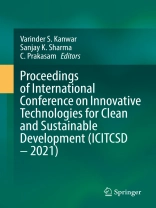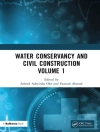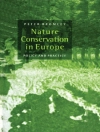This volume presents select proceedings of the International Conference on Innovative Technologies for Clean and Sustainable Development (ICITCSD – 2021), held at the National Institute of Technical Teachers Training & Research and Chitkara University, Himachal Pradesh, India. It covers several important aspects of sustainable civil engineering practices, dealing with effective waste and material management, natural resources, industrial products, energy, food, transportation and shelter, environmental impact mitigation, waste minimization and management, sustainable infrastructure, and geospatial technology for sustainable and clean environment. Emphasis is placed on conserving and protecting the environment and the natural resource base essential for future development. The book includes case studies and ongoing research work from various fields related to civil engineering presented by academicians, scientists, and researchers. The book also discusses engineering solutions to sustainable development and green design issues. Special emphasis is given on qualitative guidelines for the generation, treatment, handling, transport, disposal, and recycling of wastes. The book is intended as a practice-oriented reference guide for researchers and practitioners. It will be useful for anyone working in sustainable civil engineering and related fields.
İçerik tablosu
Chapter1. Effect of Lime And Brick Ash Inclusion on Engineering Behaviour of Expansive Soil.- Chapter2. Know your Daily Rainfall in any Location in India- A Web-based Approach Developed in Google Earth Engine.- Chapter3. Io T- Based Innovative Technological Solutions for Smart Cities and Villages.- Chapter4. A Review on Utilization of E-Waste in Construction.- Chapter5. Water Sensitive Urban Design (WSUD) for Treatment of Storm water Runoff.- Chapter6. Textile Industry Wastewater Treatment using Eco-friendly Techniques.- Chapter7. Sustainable Treatment of Metal-Contaminated Soil by Electrokinetic Remediation.- Chapter8. Eco-Restoration of lakes and water sustainability in urban areas.- Chapter9. Microplastics: Environmental Issues and their Management.- Chapter10. Elucidating the Effect of Cement Dust on Selective Soil Parameters around J&K Cements Limited, Khrew.- Chapter11. Development of Correlation between Ultrasonic Pulse Velocity and Rebound Hammer Test Results for Condition Assessment of Concrete Structures for Sustainable Infrastructure Development. Chapter12. Alternative Fine Aggregates to Produce Sustainable Self Compacting Concrete: A Review.- Chapter13. Structural Behavior of Reinforced Concrete Column Using Diamond Tie Configuration under Elevated Temperatures for Sustainable Performance: A Review.- Chapter14. Reusable and Recyclable Industrial Waste in Geopolymer Concrete.- Chapter15. Infrared Thermography Parameter Optimization for Damage Detection of Concrete Structures Using Finite Element Simulations.- Chapter16. Eco-friendly Concrete Admixture from Black Liquor Generated in Pulp and Paper Industry.- Chapter17. Behavioural study on concrete with organic materials for CO2 absorption.- Chapter18. An Efficient Design and Development of Io T based Real-Time Water Pollution Monitoring and Quality Management System.- Chapter19. Numerical Study of Composite Wrapped Reinforced Concrete Columns Subjected to Close-in Blast.- Chapter20. Evaluation of conventional red bricks with compressed stabilized earth blocks as alternate sustainable building materials in Indian context.- Chapter21. Experimental Study on Alternative Building Material using Cement and Stone Dust as Stabilizers in Stabilized Mud Block.- Chapter22. Utilizing the Potential of Textile Effluent Treatment Sludge in Construction Industry: Current Status, Opportunities, Challenges, and Solutions.- Chapter23. Identification of Suitable Solid Waste Disposal Sites for the Arba Minch Town, Ethiopia, Using Geospatial Technology and AHP Method.- Chapter24. Framing Conceptual Design of Adopting Interlocking Bricks Technology in Construction.- Chapter25. Arriving Factors in the Conceptual Design Framework of 3D Printing Techniques for Building construction.- Chapter26. Scenic Evaluation of the Hills for Tourism Development – A Study on the Hills Of Tamilnadu, India.- Chapter27. Influence of Groundnut Shell Ash and Waste Plaster of Paris on Clayey Soil for Sustainable Construction.- Chapter28. Influence of Metakaolin and Steel Fiber on Strength of Concrete – A Critical Review.- Chapter29. Decadal monitoring of Coastline shifts and recommendation of Non-structural Protection measures along the coast of Rameshwaram, Tamilnadu, India.- Chapter30. Development of sustainable concrete using slag and calcined clay.- Chapter31. Assessment of the impact of bacillus cereus bacteria on strength and water absorption capacity of sustainable concrete.- Chapter32. Design and Development of Corona-19 Pandemic Situation-based Remote Voting System.- Chapter33. Waste Pozzolanic Material as a substitute of Geopolymer Mortar.- Chapter34. Study of the carbon emissions from construction of a house in plain region using standard construction material and eco-friendly/ alternative materials.- Chapter35. Experimental investigation of the impacts of partial substitution of cement with rice husk ash (RHA) on the characteristics of cement mortar.- Chapter36. A Mini review on Current Advancement in Application of Bacterial Cellulose in Pulp and Paper Industry.- Chapter37. Effect of agro-waste as a partial replacement in cement for sustainable concrete production.- Chapter38. Analysis and Evaluation of Geopolymer Concrete from Mechanical standpoint.- Chapter39. Municipal Waste Management in India: A Critical Review of Disposal System and Model Implementation.- Chapter40. Experimental Study on Light Weight Geopolymer Concrete Using Expanded Clay Aggregate.- Chapter41. Seismic Response of Composite Bridges: A Review.- Chapter42. Assessing and Correlating the Flow Duration Curve and Drought Index for the Environmental Flow Requirements.- Chapter43. Effect on Rheological and Hardened properties of Fly ash-GGBS based High Strength Self Compacting Concrete with inclusion of Micro and Nano Silica.- Chapter44. Mechanical Property study on Glass fibre concrete with partial replacement of fine aggregate with steel slag.- Chapter45. Mechanical Properties of Geopolymer Concrete Partial Replacement of Fine Aggregate with Waste Crushed Glass.- Chapter46. A Performance Study on Lithium based admixture in the properties of concrete.- Chapter47. Self-Curing Concrete Made By Using Hemp: A Review.- Chapter48. Research Progress of India in Waste Management at Global Level: A Bibliometric Evaluation.- Chapter49. Performance Evaluation of Acrylic Based Coating on Carbonation Depth on Different Grades of Concrete.- Chapter50. Cost Benefit Analysis of Retrofitting for Existing Building as Net Zero Energy Building: A Case Study in Composite Climate Zone.- Chapter51. Advances in Building Materials Industry by Annexation of Nano Materials.- Chapter52. Experimental Investigations on Utilization of Electroplating Waste Sludge in Manufacturing of Polymer Based Checkered Tiles.- Chapter53. Alccofine as a partial substitute of cement with scrap iron slag as a coarser material in high strength non-conventional concrete as an experimentational representation. Chapter54. Water Pollution: “Dal Lake a case study”.- Chapter55. Durability Properties of Admixture of Fly ash, Bottom Ash And GBFS.- Chapter56. Comparative Studies of Compressive Strength on Different Brick Masonry Prisms.- Chapter57. Monitoring and Management of Construction Sites Using Drone.- Chapter58. Experimental Investigation on Buckling Behaviour of Transmission Tower using Cold Formed and Hot Rolled Steel.- Chapter59. Assessment of indoor air quality of buildings made of bricks developed from paper pulp waste.- Chapter60. Review on Shear Strengthened RC Rectangular beams with FRP Composites.- Chapter61. Machine Learning Based Quality Prediction of Reuse Water in Sewage Treatment Plant.- Chapter62. ‘Prediction, Impact and Mitigation of Ambient Air Quality Pollutant Concentrations in Chandigarh’ A Review.- Chapter63. A Review of Environmental Flow Evaluation Methodologies – Limitations and Validations.- Chapter64. Sustainable development of Scheduled caste and Scheduled tribes’ population in select villages of Himachal Pradesh, India: A Cross Sectional Study.
Yazar hakkında
Dr. Varinder S. Kanwar is a Professor in the Department of Civil Engineering at Chitkara University, Himachal Pradesh, India.
Dr. Sanjay K. Sharma is a Professor in the Department of Civil Engineering at the National Institute of Technical Teachers Training & Research, Chandigarh, India.
Dr. C. Prakasam is an Associate Professor in the Department of Geography, School of Earth Sciences, Assam University, Diphu Campus, (A Central University), Diphu, Karbi Anglong, Assam, India.












